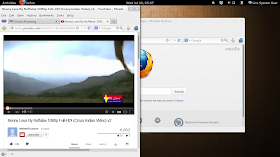 |
| Activities screen |
After the boot menu, I was greeted by the same sort of boot splash as last time. That led relatively quickly into the desktop, which is a standard GNOME 3/Shell desktop, so I won't dwell too much on that. The only thing of note is the wallpaper, for two reasons. The first is that it looks quite nice with its subtle brown shades and Korora branding. The second is that one time after logging in, it failed to load properly and I was left instead with the drab gray background from the GDM login screen lingering.
Additionally, I wanted to try the new GNOME 3/Classic desktop, but it seems like logging out and back in is not enough to enable that environment; a full reboot is required, which is of course impossible to do in a live session, and moreover, I thought rebooting after these kinds of software installations (except for kernel upgrades, of course) were relics of Microsoft Windows.
 |
| Mozilla Firefox |
LibreOffice is the default productivity suite. There aren't too many other included applications of note beyond the standard GNOME and Fedora utilities. The only other issue to note is that GNOME Files caused a hiccup in the desktop when it launched: the top bar and all the window titlebars disappeared briefly, but they thankfully returned quickly and without further issue. Also, speaking of GNOME Files, there is a file previewer included as well; I think it is GNOME Sushi, yet the list of programs shows Gloobus-Preview installed, so I'm not entirely sure what it is (both programs look fairly similar), but it works well in any case.
I was able to use the YUM Extender package manager to install Google Talk and Redshift. Both of those worked quite well.
 |
| GNOME Files + GNOME Sushi |
Korora used about 510 MB of RAM at idle, which is now significantly more than KDE. Furthermore, applications were a little slow to launch and respond to inputs, and the handful of DE-related hiccups I experienced gave me the feeling that the system was slightly unstable, and I couldn't shake this feeling off.
That's where my time with Korora 19 "Bruce" GNOME ended. The nonworking nature of Skype is a deal-breaker for me, and I suspect that is the case for a lot of newbies who might be interested in Linux as well. Most new computers now have 64-bit processors, and I as well as a lot of other users would like to put such hardware to good use with a 64-bit distribution. If I can't do what I need to do every day with such a distribution, then I can't recommend it. In fairness, given that most of the distributions I test are in 32-bit guise, it is possible that many of the positive reviews I have given in the past would on average turn more negative if I reviewed the 64-bit edition instead, but for now, it is what it is.
You can get it here as before, and don't worry, there is a 32-bit edition available for each DE shipped.